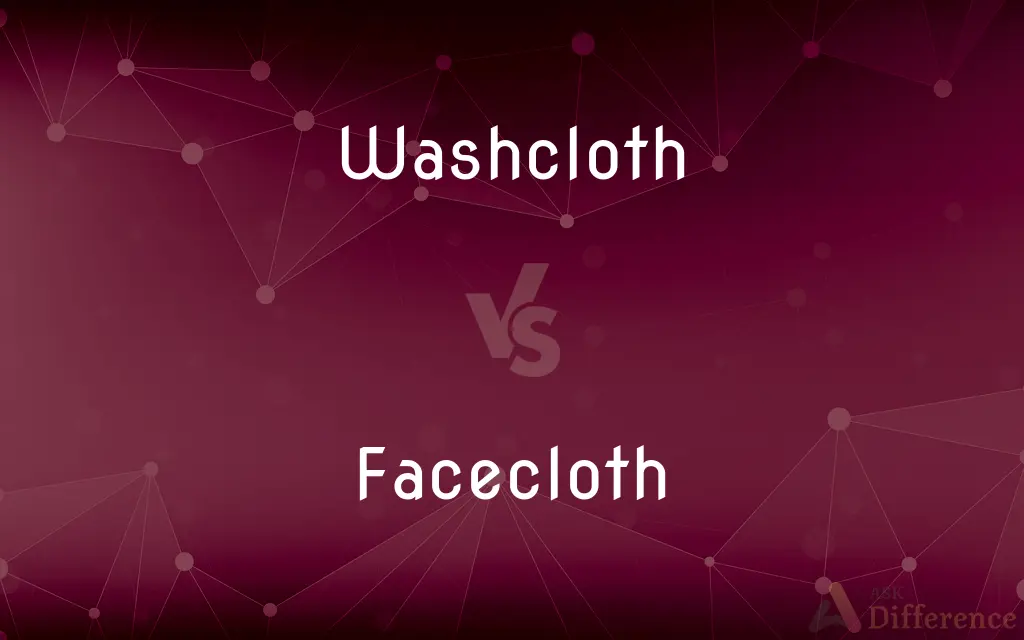Washcloth vs. Facecloth — What's the Difference?
By Fiza Rafique & Urooj Arif — Updated on April 8, 2024
A washcloth is a small cloth used for general body cleaning, while a facecloth is specifically designed for cleansing the face, often softer to suit delicate facial skin.

Difference Between Washcloth and Facecloth
Table of Contents
ADVERTISEMENT
Key Differences
A washcloth is a versatile piece of fabric, usually square and made from a durable, absorbent material such as cotton or terry cloth, intended for cleaning the body during bathing or showering. It's designed to be sturdy enough for exfoliating skin and removing dirt from all over the body. On the other hand, a facecloth, also made from soft, absorbent materials, is specifically tailored for the face, with an emphasis on gentleness to avoid irritating the more sensitive skin on the face compared to the rest of the body.
While washcloths are used for a broader range of cleaning activities, including in the kitchen or for general household cleaning tasks, facecloths are exclusively used for facial care routines, emphasizing the importance of hygiene and the prevention of cross-contamination between face and body or household uses. The distinction highlights not only the different uses but also the need for separate cloths to maintain skin health and cleanliness.
In terms of care and maintenance, washcloths may be subjected to more vigorous washing cycles due to their exposure to body oils, dirt, and potentially harsher cleaning products. Conversely, facecloths require more delicate care, often washed with gentle detergents and at cooler temperatures to preserve their softness and to prevent the breakdown of fibers that could lead to a rougher texture, which could irritate the skin.
The fabric and weave of a facecloth are usually finer and softer, catering to the delicate areas around the eyes and mouth, whereas washcloths might have a more open weave or textured surface to help with exfoliating the skin on the body. This difference in texture underlines the functional distinction between the two, with each designed to suit the specific needs of the body part they are intended for.
Despite these differences, both washcloths and facecloths share the common goal of promoting cleanliness and skincare. The choice between a washcloth and a facecloth often comes down to personal preference for skin sensitivity, desired level of exfoliation, and specific skincare routines, underscoring the personalized nature of skincare and hygiene practices.
ADVERTISEMENT
Comparison Chart
Primary Use
General body cleaning.
Specifically designed for cleansing the face.
Material
Durable and absorbent, such as cotton or terry cloth.
Softer materials to suit delicate facial skin.
Texture
Can be more textured for exfoliation.
Finer and softer to prevent skin irritation.
Care
May undergo vigorous washing cycles.
Requires gentle washing to maintain softness.
Versatility
Used for a range of cleaning tasks beyond personal care.
Used exclusively for facial skincare routines.
Compare with Definitions
Washcloth
A washcloth is a durable cloth for body cleansing.
I use a washcloth to exfoliate my skin in the shower.
Facecloth
A facecloth is a soft cloth designed for the face.
I use a separate facecloth for my morning and night skincare routine.
Washcloth
It's versatile, used in kitchens and for general cleaning.
I grabbed a washcloth to mop up the spilled juice.
Facecloth
Used in facial care routines to cleanse or apply products.
I soaked the facecloth in warm water to steam my face before applying the mask.
Washcloth
They can withstand regular, thorough washings.
My washcloths go through a hot wash cycle to ensure they are clean.
Facecloth
Facecloths help maintain facial hygiene without irritation.
Switching to a softer facecloth helped reduce my skin irritation.
Washcloth
Made from absorbent materials for effective cleaning.
The cotton washcloth quickly soaked up the soapy water.
Facecloth
It's made specifically for gentle facial cleansing.
My silk-blend facecloth is perfect for my sensitive skin.
Washcloth
Washcloths facilitate thorough body cleaning.
Using a washcloth helps remove dead skin cells during a bath.
Facecloth
Facecloths require delicate care to stay soft.
I wash my facecloths with a gentle detergent to maintain their softness.
Washcloth
A small, usually square cloth of absorbent material used for washing the face or body. Also called facecloth, washrag.
Facecloth
A small towelling cloth for washing one's face.
Washcloth
A small cloth used to wash the face and body.
Facecloth
See washcloth.
Washcloth
Bath linen consisting of a piece of cloth used to wash the face and body
Facecloth
A flannel for washing the face.
Facecloth
A cloth laid over the face of a corpse.
Common Curiosities
How often should I replace my washcloth or facecloth?
It depends on usage and wear, but it's good practice to replace them when they become rough, less absorbent, or develop an odor, even after washing.
What is the difference between a washcloth and a facecloth?
The primary difference is their intended use: washcloths for body cleaning and facecloths specifically for facial care, with facecloths being softer to accommodate sensitive skin.
Can I use a washcloth as a facecloth?
While you can, it's not recommended due to the potential for skin irritation from the harsher texture of a washcloth.
Are there specific materials that are best for facecloths?
Materials like microfiber, bamboo, or soft cotton are preferred for facecloths due to their softness, absorbency, and gentle cleansing properties, making them suitable for sensitive facial skin.
Can I use the same facecloth for different skincare products?
Yes, you can use the same facecloth for different products, but it's best to rinse it well between uses to prevent product mixing and potential skin irritation.
Is it necessary to use both a washcloth and a facecloth?
While not necessary, using separate cloths can be beneficial for hygiene and to cater to the different needs of body and facial skin.
Can using a facecloth help improve my skin's health?
Yes, using a facecloth can help by gently exfoliating the skin, removing dead skin cells, and aiding in the deeper cleansing of pores, which can improve skin health and appearance.
Is it better to use hot or cold water with a facecloth?
The best temperature depends on your skincare routine; warm water is ideal for opening pores before cleansing, while cold water can be refreshing and help close pores after cleaning.
How should I care for my facecloth?
Wash facecloths after each use with a gentle detergent and allow them to dry completely to maintain their softness and prevent bacterial growth.
Why do some people prefer facecloths over facial sponges?
People may prefer facecloths over facial sponges for their ease of cleaning, lower risk of bacterial growth, and the gentle exfoliation they can provide without the abrasiveness of some sponges.
How do I prevent my washcloth or facecloth from smelling musty?
Ensure your cloth is rinsed thoroughly after each use and hung to dry in a well-ventilated area. Regularly wash them in hot water with a mild detergent and dry them promptly.
Are there any skin types that should avoid using facecloths?
Individuals with very sensitive skin or conditions like rosacea may want to consult with a dermatologist before incorporating a facecloth into their routine to avoid potential irritation.
Can a washcloth help with body acne?
Yes, using a clean washcloth for gentle exfoliation can help remove dead skin cells and excess oil, potentially reducing body acne. However, be gentle to avoid irritating the skin further.
What's the best way to dry a facecloth to prevent bacteria growth?
After rinsing it thoroughly, wring out the facecloth and hang it in a well-ventilated area where it can dry completely between uses.
Is it environmentally friendly to use washcloths and facecloths?
Using washable and reusable cloths can be more environmentally friendly than disposable wipes or cotton pads, as they produce less waste over time.
How can I sanitize my washcloths and facecloths without damaging them?
Washing them in hot water with a gentle, fragrance-free detergent and allowing them to dry completely is usually sufficient. For extra sanitization, you can use a laundry sanitizer that's safe for fabrics.
Can I use a facecloth to remove makeup?
Yes, a soft, damp facecloth can be an effective tool for removing makeup, especially when used with a gentle cleanser or makeup remover.
How often should I use a facecloth in my skincare routine?
This depends on your skin type and needs; some may benefit from twice-daily use, while others might find once a day or every other day is sufficient to avoid over-exfoliation.
Do dermatologists recommend using a facecloth for facial cleansing?
Many dermatologists recommend using a facecloth for those who prefer a physical exfoliant as part of their cleansing routine, as it can be gentler than scrubbing with hands alone.
Can the texture of a washcloth affect its cleaning efficiency?
Yes, the texture of the washcloth can impact its ability to cleanse and exfoliate; a rougher texture might provide more exfoliation, while a smoother texture is better for sensitive skin or gentle cleansing.
Share Your Discovery

Previous Comparison
Guava vs. Guayaba
Next Comparison
Practice vs. DrillAuthor Spotlight
Written by
Fiza RafiqueFiza Rafique is a skilled content writer at AskDifference.com, where she meticulously refines and enhances written pieces. Drawing from her vast editorial expertise, Fiza ensures clarity, accuracy, and precision in every article. Passionate about language, she continually seeks to elevate the quality of content for readers worldwide.
Co-written by
Urooj ArifUrooj is a skilled content writer at Ask Difference, known for her exceptional ability to simplify complex topics into engaging and informative content. With a passion for research and a flair for clear, concise writing, she consistently delivers articles that resonate with our diverse audience.
















































